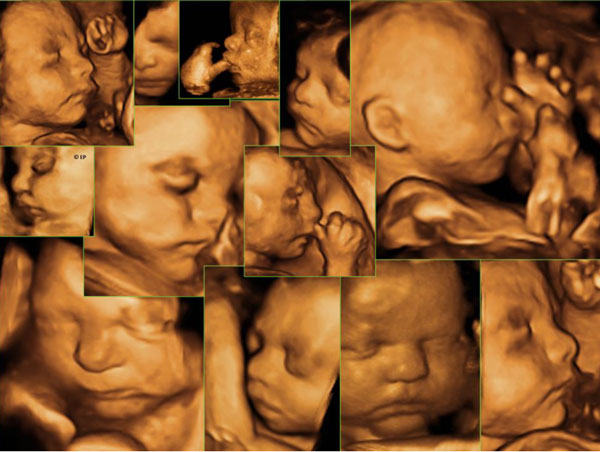3D & 4D Fetal Ultrasound
What is a 3D/4D ultrasound?
Most ultrasounds during pregnancy are done using conventional 2-dimensional (2D) scanning, during which the image displayed on the screen is only 2-dimensional. These images are in grayscale, although sometimes, the doctor can change the color of the photo using this advanced technological equipment. This type of ultrasound provides the maximum clinical information needed by the obstetrician.
In recent years, 3-dimensional (3D) and 4-dimensional (4D) ultrasounds have become increasingly popular and more widely available to patients. With 3D ultrasound, a series of 2D sections are digitally reconstructed to provide a more realistic view.
With 4D ultrasound, the added dimension is time, so it appears as if the 3D images are moving in real time. Usually, the 3D/4D images are displayed in golden color on the ultrasound screen, as this is a color that is easily distinguished by patients and highlights the baby's features.
The 3D/4D ultrasound uses ultrasound waves just like conventional 2D ultrasound, but there is further processing of the 2D images by the computer. The 3D/4D echo is just as safe as conventional 2D ultrasound and there is no evidence that it could harm you or your baby.
The 3D/4D echo has a diagnostic role in obstetrics, although it is currently limited to specific cases. For example, parents may better understand an anomaly, such as a cleft lip, when they see their child in a 3D image, as the view looks more realistic. Usually, such situations are first assessed in detail by conventional 2D ultrasound.
This is one of the reasons why it is important that your 3D/4D images, as part of your child's overall examination, be obtained by obstetricians specialized in fetal morphology, who will understand any problem your baby may have.
Most 3D/4D pregnancy photos are taken more for the pleasure of the parents than for their clinical benefit. Parents should be informed about the limitations of 3D/4D echo when undergoing the ultrasound.

When can the 3D/4D ultrasound be performed?
Many parents enjoy the connection they experience when seeing their baby in 3D/4D images.
We aim to obtain clear 3D/4D images of your baby during pregnancy. But more importantly for us is to ensure that your baby is healthy and well-developed. For this reason, 3D/4D images of your baby are often taken at the end of the examination, after the baby has been thoroughly checked in the 2D ultrasound and all routine measurements have been made. You should view the 3D/4D images of your baby as a bonus to the examination and not as the main purpose of the check-up. Hygeia Hospital has offered 3D / 4D ultrasound since 2009.
The best time to obtain clear 3D/4D images of your baby is between week 24 and week 34. Images in the earlier stages of pregnancy (for example, in the routine morphological ultrasound of weeks 18-20) look different than the pleasant face of the baby with chubby cheeks that you have seen on TV or in magazine articles.
Babies in the early stages of pregnancy do not have the same level of subcutaneous adipose tissue. This means that your baby will appear less “filled out” and more skeletal or thin in the 3D/4D images. Many parents still want to see these early 3D/4D images, especially when their child moves. Beautiful and clear 3D/4D images of your baby, especially of the face, are often seen in the ultrasound of the third trimester.
To get good 3D/4D images, the child needs to "cooperate" and there must be enough amniotic fluid in front of the structure where the image is taken. Some babies adhere to the walls of the uterus or placenta, or may have their arms and hands in front of their faces. This makes it difficult or impossible to obtain 3D/4D images. It's good for parents to look forward to seeing their child grow, but they should not be too disappointed if it's difficult to obtain 3D/4D images.